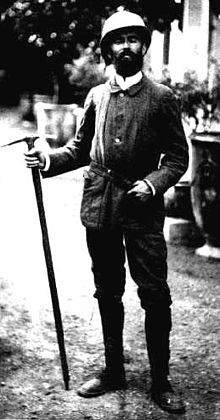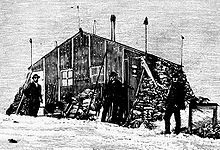Joseph Vallot
Henri Marie Joseph Vallot (born February 16, 1854 in Lodève , Département Hérault , † 1925 in Nice ) was a French private scholar .
Vallot was known as a serious amateur scientist with his broad interests in botany , glaciology , civil engineering , geology , photography , medicine , physiology , cartography , alpinism, and meteorology . Coming from a wealthy family, he was able to finance his interests largely himself.
Services on Mont Blanc
Joseph Vallot discovered his passion for Mont Blanc when he attended a geological congress in Chamonix in 1875 . At that time, apart from some observations by the Geneva naturalist Horace-Bénédict de Saussure , scientific exploration of the mountains was largely uncharted territory. Vallot first climbed Mont Blanc in 1880 and decided to build an observatory on the mountain. This at a time when medical professionals considered it very dangerous to stay overnight at such heights. In 1887, he and his mountain guides spent three nights in a tent on the Mont Blanc summit to prove that life at such an altitude is possible. He negotiated the conditions with the Chamonix community and local mountain guides to build a hut on Bossesgrat, 450 meters below the summit. The community contributed 800 Francs, the mountain guides 200 Francs, and he himself contributed 5500 Francs to the construction costs. In 1890, over 100 porters transported the necessary material up the mountain in eight days to build a hut five by three meters with two rooms, which served as a shelter and a laboratory. This first observatory was subsequently expanded and rebuilt several times. It was later made extremely comfortable and also featured a Chinese salon . In addition, a separate refuge for mountain guides and their guests was created, in which the later Pope Pius XI. stayed overnight.
One year after the first hut was built, the scientist Jules Janssen (1824–1907) was commissioned to build a state observatory on Mont Blanc. Janssen was of an advanced age and limped so that he could only get up the mountain on a sledge pulled by several guides. After Janssen's death in 1907, Janssen's observatory quickly disintegrated and its beams were used to heat the Vallot hut.
Joseph Vallot also worked on the project for a train to take tourists to Mont Blanc and on the realization of the cable car to the Aiguille du Midi .
As an avid photographer, Vallot collected images of his mountain tours. He was a co-founder of the camera manufacturer Gaumont . The Chamonix Alpine Museum keeps numerous documents on Vallot and has also rebuilt the Chinese salon of its observatory.
Joseph Vallot helped his cousin, the engineer Henri Vallot, to create a map of the Mont Blanc massif on a scale of 1: 20,000 from 1892 . This project was completed after his death by his son Charles Vallot , who also founded the famous mountain guide Guide Vallot .
Joseph Vallot is buried in the Père Lachaise Cemetery (Division 36) in Paris. A high school is named after him in his birthplace, and one street each in Chamonix and Nice. He is also the namesake for the Vallot Glacier in Antarctica.
Nowadays, the Vallot hut still exists as a bivouac box for alpinists, as well as a small observatory operated by the Center national de la recherche scientifique , directly below the emergency accommodation.
literature
- Robert Vivian: L'Épopée Vallot au Mont-Blanc. Montmélian: La Fontaine de Siloé, 1998. ISBN 978-2-84206-072-5 .
Web links
- Description of today's observatory (French)
Individual evidence
| personal data | |
|---|---|
| SURNAME | Vallot, Joseph |
| ALTERNATIVE NAMES | Vallot, Henri Marie Joseph (full name) |
| BRIEF DESCRIPTION | French private scholar |
| DATE OF BIRTH | February 16, 1854 |
| PLACE OF BIRTH | Lodève , Hérault department |
| DATE OF DEATH | 1925 |
| Place of death | Nice |


